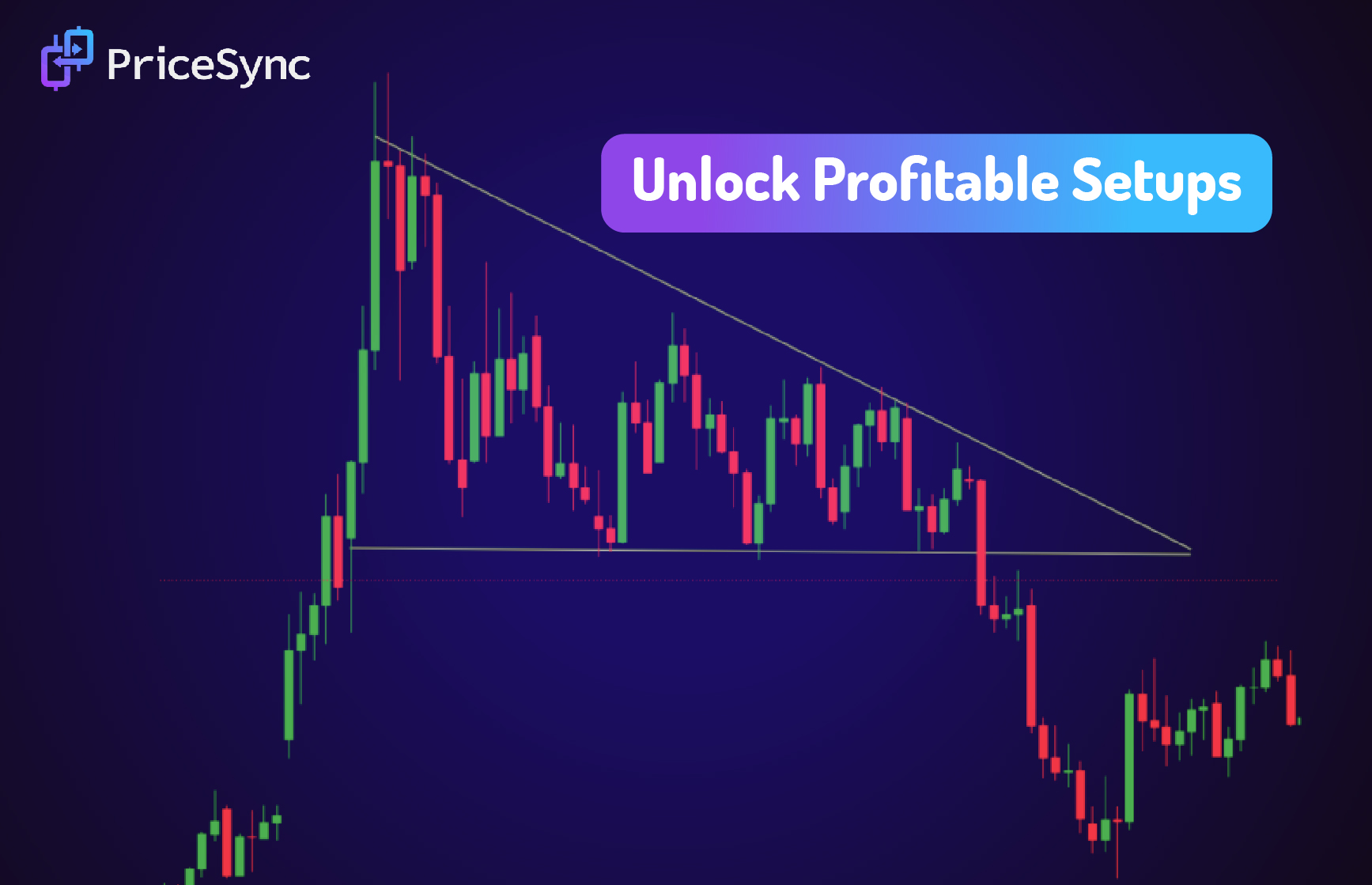
Trading descending triangle patterns is a great way to catch strong price movements in the crypto market. This pattern forms when a flat support line holds while the price makes lower highs, showing that sellers are getting stronger. In most cases, this leads to a bearish breakout, making it an important signal for traders.
Studies show that descending triangle breakouts are over 60% accurate, meaning they often predict the next big move. Around 54% of the time, the price drops sharply, while in some cases, it breaks out upward. The average price drop after a breakout is 20% to 30%, giving traders a good chance to profit. If the trading volume increases by at least 30% during the breakout, the move is more reliable.
At PriceSync, we provide expert price action analysis and free daily setups to help you trade with confidence. Our detailed charts make it easy to spot descending triangles, plan trades, and reduce risk.
In this guide, you’ll learn how to identify descending triangles, use proven trading strategies, and avoid common mistakes to improve your trading success.
What is a Descending Triangle Pattern?
A descending triangle pattern is a chart setup that can help you predict future price moves in the crypto market. It shows up when there is a flat support line at the bottom and a declining resistance line at the top. As the price moves between these lines, it keeps making lower highs but stays above the same support level.
This pattern is important because it often signals a potential bearish breakout, meaning the price could drop below support. When the price breaks the support level, it’s a strong signal for traders to look for short positions, betting that the price will keep falling.
In crypto markets, patterns like this happen often due to high volatility. The descending triangle shows that sellers are getting more aggressive, pushing the price down, while buyers are struggling to keep it up.
How to Identify a Descending Triangle on Charts?
To spot a descending triangle pattern on your charts, look for these key visual clues:
Lower Highs: The price keeps making lower highs. For example, in a strong trend, the price might reach $20,000, then drop to $18,000, then try to go back up to $19,000, but only reach $17,000 before dropping again. Each high is lower than the one before. This shows that buying pressure is fading.
Horizontal Support: There’s also a horizontal support line, where the price keeps bouncing off the same level. For instance, it could keep bouncing at $16,500, showing that buyers are trying to push it higher, but the sellers are in control at the same time.
Shrinking Price Movement: The price range gets smaller over time. For example, the difference between the highest and lowest points might go from $1,500 to $1,000 to $500. This narrowing range means a breakout is coming.
To confirm the pattern, you can draw trendlines. The resistance line slopes down, while the support line stays flat. Once the price breaks below the support, you know the pattern is confirmed.
Also, volume analysis helps. During the formation of the descending triangle, you might see lower volume as traders are unsure. But when the price breaks below support, watch for a spike in volume. For example, if volume jumps by 50% or more, it confirms that the breakout is real, and the price is likely to keep dropping.
Trading Strategies for Descending Triangle Patterns
When trading descending triangle patterns, it’s important to use strategies that give you the best chance of success. Here’s a more detailed look at the strategies that can help you make better trading decisions.
Breakout Strategy
The breakout strategy is when you enter a trade once the price breaks below the support line. This is a strong signal that the price might continue to fall. In fact, over 60% of descending triangle patterns lead to downward breakouts, making this a popular strategy among traders.
When the price breaks below support, you’re looking for confirmation that the trend is continuing. A strong increase in volume when the breakout occurs can signal that there is real momentum behind the move. If there’s little volume, the breakout could be weak and lead to a false signal.
After the breakout, you can set your price target based on the height of the triangle. For example, if the triangle’s height is 100 points, you can expect the price to move another 100 points after the breakout.
Retest Strategy
The retest strategy comes into play after the initial breakout. Once the price breaks below the support level, it often comes back to retest the same level. This is where the broken support turns into resistance. A retest provides a better entry point because it allows you to confirm that the trend is really turning down.
In fact, about 50% of the time, after a breakout, the price will come back and test the broken support before continuing downward. This offers a lower-risk entry because you’re waiting for confirmation that the pattern is truly playing out.
Watch for signs of rejection when the price retests the support-turned-resistance level. If you see a candlestick pattern like a bearish engulfing or a doji, it’s a sign the price is likely to continue downward. This gives you a more reliable entry point.
Stop-Loss Placement
Stop-losses are essential for risk management. Since descending triangle patterns often signal a continuation of the trend, placing a stop-loss above the previous resistance level can protect you if the market moves against you.
A good rule of thumb is to place your stop-loss just above the resistance line, especially if the price goes above it briefly after the breakout. This way, you limit your risk to a small portion of your total capital. Many successful traders recommend risking no more than 1-2% of your total account on a single trade.
As the trade progresses, tighten your stop-loss to break even or a small profit once the trend starts to play out. This protects your profits and allows you to stay in the trade if the market continues in your favor.
Common Mistakes to Avoid When Trading Descending Triangle Patterns
When trading descending triangle patterns, there are a few common mistakes that can easily lead to poor decisions. Let’s explore them to help you trade more confidently.
Misinterpreting False Breakouts
One of the biggest pitfalls is getting caught in a false breakout. A false breakout happens when the price momentarily breaks through support but then quickly returns, leaving traders trapped in a losing position. Always wait for confirmation before jumping in. Look for a sustained break followed by a retest or continuation to confirm the trend.
Ignoring Market Trends and Volume Confirmation
Ignoring the overall market trend and volume confirmation is another mistake many traders make. A descending triangle can break down, but if the market is in an overall uptrend, the breakout might not have enough strength to continue. Similarly, volume plays a crucial role-low volume during the breakout, could mean a weak move. Always factor in market conditions and volume analysis for a more informed decision.
Overtrading Based on Assumptions Instead of Clear Signals
It’s tempting to trade based on assumptions or gut feelings, but this often leads to overtrading and unnecessary risk. Instead of jumping into every pattern, wait for clear signals. Focus on setups that match your trading plan and risk profile.
How PriceSync Helps You Trade Better
PriceSync is here to help you trade descending triangles more effectively with expert chart setups and real-time updates.
Daily Chart Setups: At PriceSync, we provide fresh, daily chart setups based on expert price action analysis. This helps you spot descending triangles early so you can make well-timed entries and exits.
Expert Price Action Analysis: Our analysis is rooted in price action, which means you can trust the setups to reflect the true market conditions. We focus on what’s actually happening on the charts, not just theory.
Real-Time Updates: PriceSync keeps you in sync with the latest crypto market trends. This allows you to adjust your strategy based on current conditions, helping you stay ahead of the market and trade with confidence.
Final thoughts
Mastering trading descending triangle patterns can significantly enhance your trading strategy and help you stay ahead in the crypto market. By avoiding common mistakes like misinterpreting false breakouts, ignoring market trends, and overtrading, you'll be in a much better position to make informed decisions.
At PriceSync, we provide daily chart setups that highlight these key patterns, backed by expert price action analysis and real-time updates. With our fresh insights, you can better spot and trade descending triangles, making smarter moves in line with the current market conditions.
Are you ready to take your trading to the next level and apply these insights to your strategies? Explore the latest crypto market trends and sharpen your skills with PriceSync today!


 Crypto Trading
Crypto Trading 02:59 PM
02:59 PM
Leave a Comment: